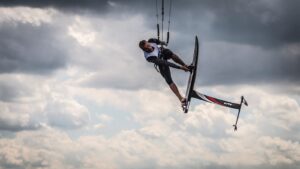Support our hydrofoil educational content for free when you purchase through links on our site. Learn more
How Does a Hydrofoil Move Forward? [2023]
Have you ever wondered how a hydrofoil moves forward? It’s a fascinating concept that combines physics, engineering, and the thrill of riding on water. In this article, we will dive deep into the mechanics of hydrofoiling and explain how it all works. So, grab your board and let’s get started!
Quick Answer
A hydrofoil moves forward by utilizing the lift generated by its wings, which are submerged underwater. As the hydrofoil gains speed, the wings create lift, causing the board to rise out of the water. This reduces drag and allows the hydrofoil to glide smoothly above the surface, achieving higher speeds and a more efficient ride.
CHECK PRICE on: Amazon | Walmart | Etsy
Quick Tips and Facts
Before we delve deeper into the mechanics of hydrofoiling, here are some quick tips and facts to keep in mind:
- Hydrofoiling is a thrilling water sport that combines surfing, kiteboarding, and wakeboarding.
- The hydrofoil consists of a mast, fuselage, front wing, and back wing.
- The surface area, wingspan, and aspect ratio of the hydrofoil are important metrics to consider when selecting a hydrofoil.
- Efoiling, the next evolution of hydrofoiling, has gained popularity in recent years, offering a fast, quiet, and emission-free riding experience.
Background: The Beginnings of Hydrofoiling
Hydrofoiling has a rich history that dates back to the early 20th century. The first hydrofoil designs were developed by Italian engineer Enrico Forlanini in the early 1900s. These early hydrofoils were primarily used for military purposes, such as torpedo boats and patrol vessels.
Over the years, hydrofoiling technology evolved, and the sport started gaining traction among water sports enthusiasts. Today, hydrofoiling has become a popular activity for surfers, kiteboarders, and even boat enthusiasts looking to enhance their speed and efficiency on the water.
The Growth of Foiling: From Niche to Mainstream
In recent years, hydrofoiling has experienced a significant surge in popularity, thanks to advancements in technology and increased accessibility. What was once a niche sport has now become more mainstream, with hydrofoil boards and efoils becoming more readily available to the general public.
Efoiling, in particular, has played a significant role in the growth of hydrofoiling. Efoils are electric-powered hydrofoil boards that allow riders to experience the thrill of hydrofoiling without the need for wind or waves. These electric-powered boards have made hydrofoiling more accessible to people of all skill levels, as they provide a stable and user-friendly riding experience.
The Physics Behind the Hydrofoil
To understand how a hydrofoil moves forward, we need to delve into the physics behind it. At its core, hydrofoiling relies on the principles of lift and drag.
When a hydrofoil is in motion, the wings generate lift as water flows over them. This lift force is perpendicular to the direction of motion and acts in an upward direction. As the lift force increases, it counteracts the force of gravity, causing the hydrofoil to rise out of the water.
As the hydrofoil gains speed, the lift force becomes greater than the weight of the board, allowing it to fully rise out of the water. This reduces the drag caused by the water’s resistance, enabling the hydrofoil to glide smoothly above the surface.
These Are the Foil Metrics You Should Have in Mind When Selecting Your Hydrofoil
When selecting a hydrofoil, there are several important metrics to consider. These metrics determine the performance and characteristics of the hydrofoil, allowing riders to choose the right one for their skill level and riding style. Here are the key metrics to keep in mind:
-
Surface Area: The surface area of the hydrofoil wings affects the lift generated. Larger surface areas provide more lift at slower speeds, making them suitable for beginners. Smaller surface areas offer more maneuverability at higher speeds.
-
Wingspan: The wingspan of the hydrofoil wings affects stability. A longer wingspan provides more stability, making it easier to control the hydrofoil. A shorter wingspan offers more maneuverability and allows for sharper turns.
-
Aspect Ratio: The aspect ratio of the hydrofoil wings determines their efficiency. Low aspect ratio wings create more lift at lower speeds and are easier to control, making them suitable for beginners. High aspect ratio wings are more efficient for pumping and require more skill to control on waves.
By considering these metrics and understanding their impact on performance, riders can choose a hydrofoil that suits their needs and riding style.
Is the Future of Hydrofoil Surfboards Electric?
Efoiling has revolutionized the world of hydrofoil surfing, offering a new and exciting way to experience the sport. But what does the future hold for hydrofoil surfboards? Will electric-powered boards dominate the market?
While efoiling has gained significant popularity, traditional hydrofoil surfboards are still widely used and loved by enthusiasts. Both electric and non-electric hydrofoil surfboards have their own unique advantages and appeal to different riders.
Electric-powered hydrofoil surfboards, such as the Takuma Efoil range, offer a convenient and emission-free riding experience. They are suitable for riders of all skill levels and provide a stable and user-friendly platform for hydrofoiling.
On the other hand, non-electric hydrofoil surfboards require wind or waves to generate speed and lift. They offer a more traditional and challenging riding experience, requiring riders to harness the power of nature to glide above the water.
Ultimately, the future of hydrofoil surfboards is likely to be a combination of both electric and non-electric options. As technology continues to advance, we can expect to see further innovations in both categories, providing riders with more choices and opportunities to enjoy the thrill of hydrofoiling.
The Takuma Efoil Range: Taking You Further
When it comes to electric-powered hydrofoil surfboards, the Takuma Efoil range stands out as a leader in the industry. Designed with performance, stability, and ease of use in mind, the Takuma Efoil range offers an exceptional riding experience for hydrofoil enthusiasts.
The Takuma Efoil range includes two main models: the Cruising 2 and the Carver 2.
-
The Cruising 2 is designed for stability and ease of use, making it suitable for both beginners and experienced riders. It offers a user-friendly platform for learning and progressing in the sport of hydrofoiling.
-
The Carver 2 is focused on minimizing drag and maximizing comfort for carving sessions. It provides superb performance, excellent responsiveness, and precise maneuverability, making it the perfect choice for carving enthusiasts looking to take their skills to the next level.
Whether you’re a beginner looking to get started in hydrofoiling or an experienced rider seeking the ultimate carving experience, the Takuma Efoil range has something to offer.
CHECK PRICE on: Amazon | Walmart | Etsy | Takuma Official Website
FAQ

How is a hydrofoil propelled?
A hydrofoil is propelled by utilizing the lift generated by its wings. As the hydrofoil gains speed, the wings create lift, causing the board to rise out of the water. This reduces drag and allows the hydrofoil to glide smoothly above the surface, achieving higher speeds and a more efficient ride.
Read more about “Do Foil Boards Have Motors? …”
What propels a hydrofoil?
The propulsion of a hydrofoil is primarily achieved through the lift generated by its wings. As the wings create lift, the hydrofoil rises out of the water, reducing drag and allowing for faster speeds. Additionally, some hydrofoils may also utilize additional propulsion systems, such as electric motors or sails, to enhance their speed and performance.
Read more about “How do hydrofoils float? …”
How does a foil board work physics?
The physics behind a foil board are based on the principles of lift and drag. When a foil board is in motion, the wings generate lift as water flows over them. This lift force acts in an upward direction, counteracting the force of gravity and causing the board to rise out of the water. As the board gains speed, the lift force becomes greater than the weight of the board, allowing it to fully rise out of the water and glide smoothly above the surface.
How does a hydrofoil work on a boat?
When a hydrofoil is attached to a boat, it lifts the vessel out of the water as it gains speed. This lifting action reduces the drag caused by the water’s resistance, allowing the boat to achieve higher speeds and improved fuel efficiency. The hydrofoil consists of wings that generate lift, a mast that connects the wings to the boat, and a fuselage that provides stability and control.
Read more about “Hydrofoil Boat: All You Need to Know …”
Conclusion
Hydrofoiling is an exhilarating water sport that combines the thrill of surfing with the efficiency of flight. By harnessing the power of lift and drag, hydrofoils are able to glide smoothly above the water’s surface, achieving higher speeds and a more efficient ride.
Whether you’re a beginner looking to get started in hydrofoiling or an experienced rider seeking the ultimate carving experience, there is a hydrofoil out there for you. Consider the important metrics, such as surface area, wingspan, and aspect ratio, when selecting a hydrofoil that suits your needs and riding style.
If you’re looking for an electric-powered hydrofoil surfboard, the Takuma Efoil range offers exceptional performance, stability, and ease of use. With models like the Cruising 2 and the Carver 2, Takuma provides riders with a range of options to take their hydrofoiling experience to the next level.
So, grab your hydrofoil board, hit the water, and experience the thrill of gliding above the surface like never before!
Recommended Links
- Hydrofoil Basics
- Hydrofoil History
- Advanced Hydrofoiling Techniques
- Hydrofoil Equipment Reviews
- How Does Hydrofoil Generate Lift? 2023



